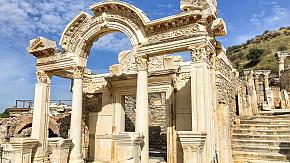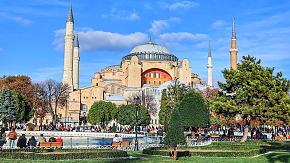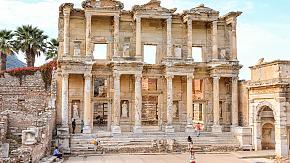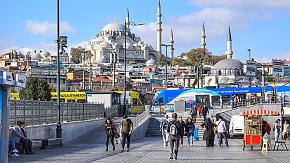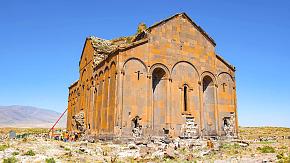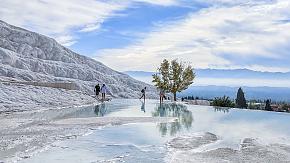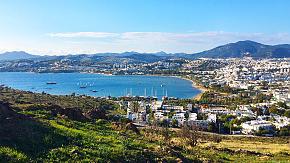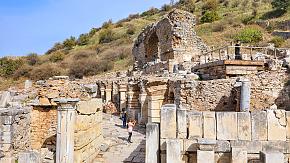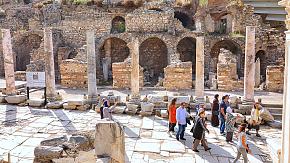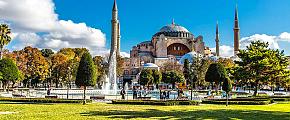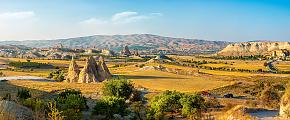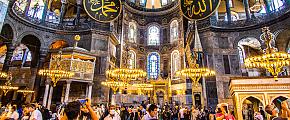10 Historical Places in Turkey That You Must See
Sitting at the frontier between Asia and Europe and bordering on the Aegean Sea and Greece, Turkey has served as a significant geopolitical crossroads connecting the two continents. The country has witnessed the rise and fall of many empires: the Greeks and Romans, the Byzantines, the Seljuq Empire, and the Ottomans. The influences of many types of civilizations, together with adaptation, are responsible for a wide range of historical legacies in Turkey.
Turkey is so characteristic of ancient treasure troves that it has always been a hugely popular destination for history lovers all over the world. Here, we have chosen ten wonderful historical sites that you must visit during your tour to Turkey.
Hagia Sophia
 Hagia Sophia
Hagia Sophia
In the 4th century A.D., in order to expand the influence of the Roman Empire to the east, Constantine the Great of the Byzantine Empire moved his capital to Byzantium, renamed it Constantinople (now Istanbul, Turkey), and began building his city to showcase the power of the Roman Empire. This led to the world-famous Byzantine structure, Hagia Sophia. It was built in 532 A.D., during the reign of Byzantine Emperor Justinian I.
As the main church of the Byzantine Empire, Hagia Sophia witnessed the prosperity of the Byzantine Empire. It was then occupied by the Turks after 1453 and converted into a mosque. And it was designated part of UNESCO's list of World Heritage Sites in 1985.
Hagia Sophia is characterized by a huge 32-meter dome and two semi-domes that are fringed by chandeliers. The interior of Hagia Sophia is decorated with beautiful paintings on colored glass. Its mosaic floor, walls, and columns are made from colorful marble.
You can discover decorations full of patterns and designs at any corner of Hagia Sophia. The mosque is embellished with Christian and Islamic frescoes. If you take a sketchy visit to the mosque, you may miss something important.
Blue Mosque
The Blue Mosque, located in Istanbul, stands across from the Hagia Sophia. The Blue Mosque is an ideal next destination after a visit to Hagia Sophia. It is another world-famous Byzantine structure that is counted as one of the world's ten wonders. The stunning human creation is now a landmark in Istanbul. It was built by a young sultan in the early 17th century.
Around the outside of the complex are six Islamic minarets. It was created with more than 30 domes. The Blue Mosque's main feature is the exterior architecture, which is made up of over 20,000 ceramic tiles. The mosque is built with 260 small windows that offer its interior a tranquil shade of turquoise when the sunlight floods in.
The interior splendor is breathtaking. The interior of the central dome is decorated with brilliant tiles in a blue and white design. You will be impressed by the exquisite purple carpets while you visit the interior. What's more, the Blue Mosque houses a vast collection of Arabic calligraphy.
At night, the whole architecture will be lit by bright lights, which gives tourists a different sight.
Ephesus
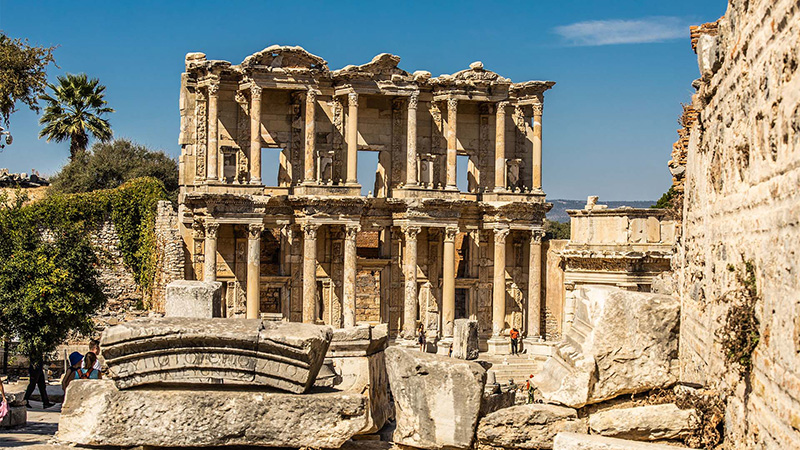 Ephesus
Ephesus
Ephesus, an old city of over 5000 years, is near the mouth of the Cayster River, adjacent to the Aegean Sea. The ancient Greeks and Romans together brought prosperity to the city. Ephesus often referred to as the "Pompeii of Turkey," is one of the most completely preserved ancient Greek and Roman cities on the eastern coast of the Mediterranean. The old city left a large collection of treasures on Turkish land.
The Memmius Monument and the Temple of Hadrian, both of which are lined with ancient streets, can be found here. But the Great Theater and Temple of Artemis are the highlights. The theater was first built in 300 B.C. in ancient Greece and was expanded during the reign of the Roman Empire. It is a perfect fusion of ancient Greek and Roman architecture.
The theater was used for drama performances and wrestling, and it is still used for festivals and meetings. Built along a hill, the semicircle theater centers around the stage and could hold nearly 25 thousand spectators. Considered one of the ancient world's seven wonders, the Temple of Artemis was built around 550 B.C.
The temple was dedicated to the goodness of Artemis, who takes charge of hunting, fertility, and the protection of the newborn. The former temple was dramatically gorgeous but was reduced to ruins in a fire. Even so, the ruins of the temple remain so impressive that they are visited by many tourists every year. Whatever historical site you visit, you will miss the past glory of ancient Greece and Rome.
Topkapi Palace
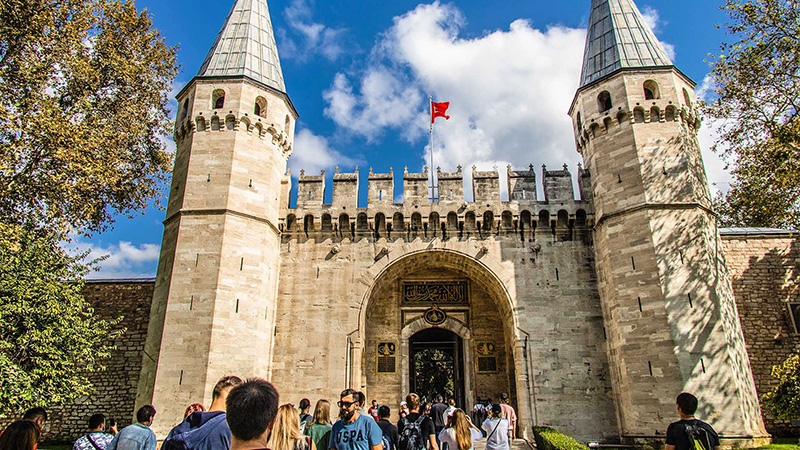 Topkapi Palace
Topkapi Palace
Located in Istanbul, Topkapi Palace is one of the most popular attractions in Turkey. It was first built in 1459 and served as the administrative headquarters and residence of the sultans of the Ottoman Empire between 1465 and 1853. The palace is an iconic site of traditional Ottoman architecture.
Surrounded by staggering 5-kilometer-long walls, Topkapi Palace covers an area of some 700,000 square meters. It features many exhibition halls, courts, a treasure house, and a harem.
Topkap's Treasury, on the eastern edge of the Third Court, boasts a staggering collection of jewelry that is made from or decorated with jade, diamonds, emeralds, and pearls. A large number of suits of armor, Ottoman paintings, Islamic calligraphy, and frescoes are also impressive sights to see.
What's more, the palace houses a vast collection of over 20,000 eye-catching pieces of porcelain, a treasure trove that was made during the Song, Yuan, Ming, and Qing dynasties. Even the interior of the palace is filled with delicate decorations. There are a large number of tourists who come to see its Muslim and Christian relics every year.
Cappadocia Underground Cities
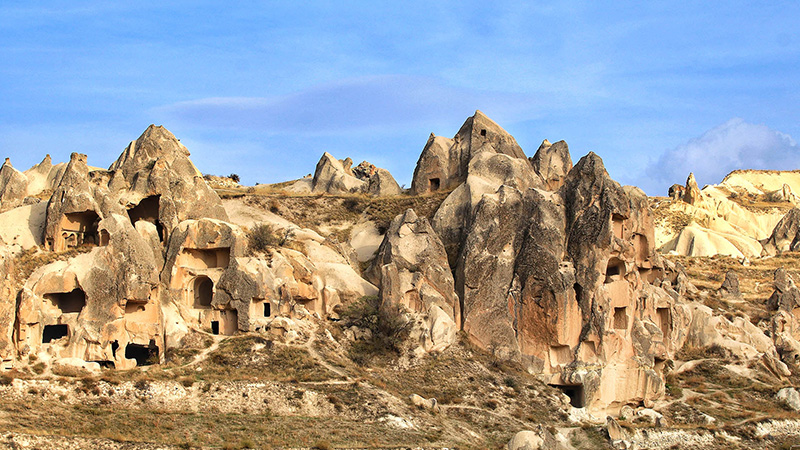 Capadocia
Capadocia
Cappadocia is a historic city located in west-central Turkey. Because of its lunar surface-like landscape, Cappadocia attracts millions of tourists each year to admire the strange pink and yellow rock formations and take hot air balloon rides.
But more than 85 meters below Cappadocia lies a vast underground city complex of 36 small cities that have been discovered. This series of subterranean cities, called Elengubu, was used for thousands of years by a succession of people, from Phrygians to Persians to Byzantine-era Christians. But it was eventually abandoned and was discovered by a local farmer in 1963.
Elengubu contains eighteen floors of tunnels, cleverly constructed with bedrooms, workshops, kitchens, armories, storage rooms, and other sites that could house nearly 300,000 people in total. The first level is a living area with a kitchen, dining room, and bedrooms; the second level is a church that is part of the administrative center; and the third and fourth levels contain a church school and warehouses.
Visitors can experience the hardships and cruelty of underground life along the dimly lit tunnels. As a refuge for the inhabitants of different empires, Elengubu has witnessed many historical legends and is definitely one of the must-see attractions for visitors to Cappadocia, in addition to the stunning natural scenery.
The Basilica Cistern
Sitting not far from the Blue Mosque, the Basilica Cistern rests beneath the surface of Istanbul. This subterranean structure is counted as one of the most mysterious wonders in the world. In fact, the Basilica Cistern was once built as a water storage reservoir to provide water for the nobles of Constantinople in Byzantine times. The whole cistern was said to store 100,000 tons of water.
Flooded by water, the Basilica Cistern is characteristic of 336 adorable marble columns and vaulted ceilings on a grand scale. Most of the columns came from abandoned buildings at that time.
Among these columns, two depicting the head of the mythological figure of Medusa are a prospect that tourists find particularly appealing. The two unidentified pedestals are in the northwest corner of the cistern. In Greek mythology, Medusa could petrify those who looked at her. The weird placement of Medusa's head (upturned or lying on one's side) serves as a way to protect the significant architecture and visitors in Byzantine culture.
On the whole, the symmetry of the cistern gives great visual satisfaction, and the dimly lit ambiance, coupled with dripping water, offers explorers an air of deep mystery.
Aspendos Theater
Maybe you have seen a certain number of amphitheaters and theaters across the world. But you won't be proud if you have not yet visited the Aspendos Theater. It is widely considered the best-preserved ancient Roman theater in the world. The theater, which is located in the ancient city of Aspendos in southern Turkey, is notable for its sheer scale and extremely well-preserved amphitheater.
It was built during the reign of the Roman Empire and was designed by Zenon, son of Theodorus, as known from the inscriptions on its walls. In addition, the inscriptions that inform tourists about the more detailed construction are worth seeing. Although the structure was built in ancient Roman times, it also has Greek characteristics since its city was once conquered by Greeks, Persians, and then Romans.
The theater measured 96 meters in overall width and was equipped with an impressive two-story stage and seating rows that were decorated with marble carvings. Surprisingly, this ancient theater is still in use today. The annual Antalya Opera and Art Festival is held at the theater. If you happen to catch the festival, you will be strikingly impressed by its acoustic effect from 2000 years ago.
The Bodrum Castle
The Bodrum Castle also referred to as the Castle of St. Peter, is one of the most dramatic tourist attractions in Turkey. Considered one of Bodrum's most iconic landmarks, the historical structure can be seen on countless local postcards and in travel magazines. It stands out on the shores of the Aegean Sea.
The castle was created by the Knights of the Hospital of St. John of Rhodes, an establishment that dispenses health care to sick or injured pilgrims. According to archaeological findings, the castle was constructed with a staggering 160000 stones. It was used as a military base, public bathroom, and prison for a long time.
The Bodrum Castle recorded many historical legends about different battles and historical groups, like the Crusades and the army of the sultan. In 1962, the Bodrum Castle was established as an underwater museum. Since the founding of the museum, the old castle has attracted a growing number of visitors from around the world.
One of the most notable relics is Uluburun, a well-preserved shipwreck, and it is wonderful to pass through the intricate tunnels and explore a lovely garden in the castle. Besides, the top of the structure has a beautiful seascape to offer.
Alanya Castle
If you want to know the city of Alanya, you must know the Alanya Castle first. Alanya Castle will tell you all the history of this city. The prominent fortress sits in the heart of Alanya on a peninsula to defend the city. Its original structure is thought to have been built in the 3rd century B.C. During the Byzantine era, fortification was rebuilt and improved. It gets its current appearance as a Seljuk fortress built in 1220 by Alaeddin Keykubat I. The original castle had 140 towers, nearly 400 cisterns, and long walls measuring 6500 meters. The long walls take time to stroll along, but they are a powerful record of many civilizations and cultures, from the Byzantine Empire to the Ottoman Empire to the Seljuk Dynasty.
You may be excited when you discover a considerable collection of obscure symbols and inscriptions carved into the walls. Today, the castle is used as an open-air museum that is a treasure trove of archaeological relics dating back to the Byzantine Empire, Ottoman Empire, and Seljuk Dynasty.
Besides, the citadel, the top-most part of the castle, would be a good place to enjoy the Mediterranean and the sunset over the sea.
Van Castle
Overlooking what is now the modern city of Van, Van Castle is located on a hill on the shores of Lake Van, about 4 kilometers southwest of the city center of Van. The Iron Age castle was built as a massive stone fortification during the reign of Urartu from the ninth century BC to the seventh century BC. It has witnessed confrontations among several empires, such as the Urartu Kingdom and the Assyrian Kingdom.
Van Castle is the city's most important landmark and a must-see for visitors to Van. Visitors have to climb up a long flight of stone steps to reach the castle. The lower part of the castle is built of basalt, and the majority of the rest is made of brick.
There are many Urartu stone monuments and inscriptions at the castle ruins. The site of the castle also contains Süleyman Han Cami and Ulu Cami, which offer a view of the dark blue Lake Van and the beautiful snow-capped mountains, as well as a glimpse of the ancient city of Van.
At nightfall, the sunset over Lake Van makes for a beautiful picture when viewed from the mountaintop.
Turkey has been at a crossroads of East and West for over 4000 years. The historical sites are strong evidence of the rise and fall of Turkey, and they have both Turkish cultures and splendid civilizations of ancient empires to offer visitors. These awfully dramatic expressions of history and culture are definitely a particular reason for falling in love with Turkey.
Turkey abounds in a wide variety of cultural forms in addition to the above-mentioned historical sites. If you show greater interest in the country, contact us. We'll share detailed information with you. If you want to take a trip to Turkey, we're happy to design a tailor-made itinerary for you based on your personal requirements. Travel with us, and you'll have an excellent experience during your visit to Turkey.
Related Posts You May Like
What Our Clients Say
Explore the latest verified reviews of Odynovo's travel services on Tripadvisor, Google, Trustpilot, Product Review and more trusted platforms.

